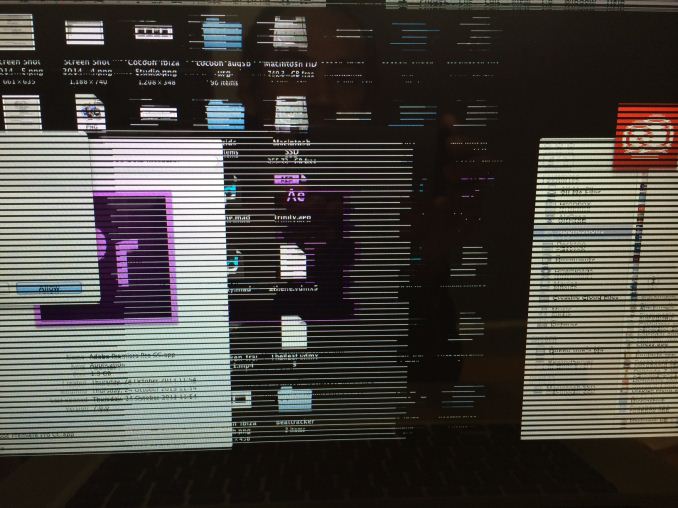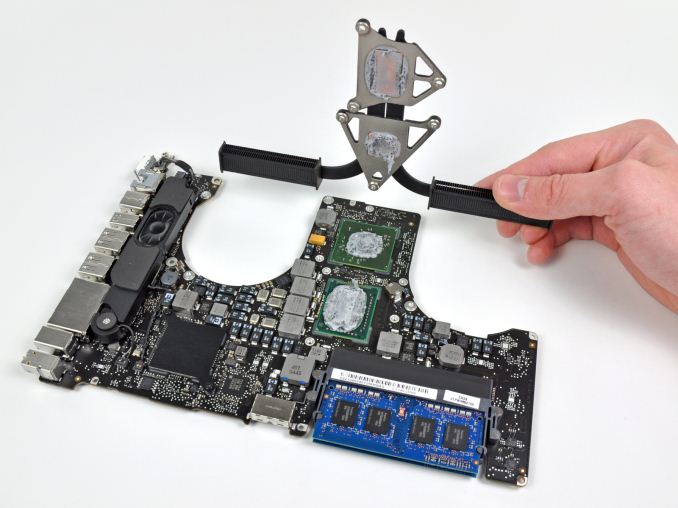Apple Initiates Video Repair Program for 2011-2013 MacBook Pros
by Ryan Smith on February 20, 2015 8:00 AM EST- Posted in
- GPUs
- AMD
- Apple
- MacBook Pro
- NVIDIA

This week Apple has announced that they are initiating a new repair extension program for the MacBook Pro, in order to address video corruption and stability problems with certain models. The program offers extended repair service for the 15” and 17” 2011 MacBook Pros, along with the 2012 and Early 2013 15” Retina MacBook Pros.
Under the terms of the program, covered laptops that are experiencing video issues such as display corruption, system crashes, or other glitches will be eligible for free repairs through Apple. Furthermore all affected systems are eligible regardless of warranty status, making this a true extension in every sense of the word as the bulk of the systems this program covers are past their extended warranty expiration dates. Meanwhile in order to compensate any users who have already suffered from the issue, Apple is also offering reimbursements to those customers who have already paid for repairs.

MacBook Pro Display Corruption (Image Courtesy 9to5Mac)
The MacBook Pro repair program comes less than 2 years after Apple’s last repair program, which in 2013 saw Apple offering free video card replacements and repairs for the mid-2011 27” iMac. And given the similarities between the problems in the MacBook Pro and the iMac, this has raised a few eyebrows. While the 2011 iMac and MacBook Pros use different GPUs, both systems use GPUs from AMD’s Radeon HD 6000M series, with the iMac using the higher-end 6970M while the MacBook Pros used the 6490M, 6750M, and 6770M GPUs.
However throwing a wrench into any common thread between these systems, the last of the MacBook Pros covered by the repair program, the first generation 15” Retina MacBook Pros, used NVIDIA’s GeForce GT 650M instead. There is also the matter of differences in construction – iMacs used MXM cards, MacBook Pros use GPUs soldered on to the logic board – and even differences in operation. Namely, while the iMac used its dGPU exclusively the MacBook Pros all used switchable graphics, which means that the MacBook Pros are often being driven by their iGPU rather than their dGPU.

Early 2011 15" MacBook Pro: CPU & GPU Cooling; the GPU is the topmost chip (Image Courtesy iFixit)
Consequently while we first suspected that this is a common issue revolving around the Radeon HD 6000M series – and certainly we can’t rule that out – there seems to be more that’s going on here than a common failure in one line of GPUs. This could include Apple opting to address multiple modes of failure under a single repair program, or even just pure coincidence. At the same time we haven’t seen a widespread repair program issued by other OEMs for any of these GPUs, which may mean that Apple is the only OEM being seriously affected, unlike NVIDIA’s bumpgate which saw repair programs from a number of OEMs.
For that reason I find myself wondering whether another factor such as cooling has been playing a role here. Although these Apple devices all use different coolers, one common element in Apple’s iMac and Retina MacBook Pro designs has been the comapny's aggressiveness in controlling the thickness of those devices, leading to them pushing the envelope on cooling relatively high TDP processors in tight spaces.
In any case, the full details of the program, including the affected models and repair instructions, are available over at Apple’s website.
Source: 9to5Mac










59 Comments
View All Comments
trparky - Friday, February 20, 2015 - link
Apple isn't the only computer maker that's been having issues with graphics card chips overheating in notebook computers. I've come to the simple conclusion, if you want a high-end graphics card... get a desktop. Notebooks simply don't have the space needed for the required cooling for a high-end graphics chip.Both my brother's and father's HP notebooks with decent graphics chips in them suffer for overheating from one degree or another. My brother's notebook gets so hot that you can feel the heat through the keyboard. My father's notebook gets so hot that the graphics chip fails and causes the Windows WDDM driver to restart.
As I stated above, I have come to the conclusion that if you want a high-end graphics card... get a desktop.
wurizen - Friday, February 20, 2015 - link
It's PC manufacturer supply and demand scheme or greed screwing Apple in the end. I say that because the PC space is a rat race. Components being built by who knows what standard. And Apple products whose standards are higher are having to share the same space of lowest common denominator.Dr_Orgo - Friday, February 20, 2015 - link
Claiming that you can't have a decent GPU in a notebook is stupid. Using an HP notebook as the basis of your claim is even more stupid. If you want a dedicated GPU in a notebook, buy one designed with that TDP in mind. Thin and light gaming notebooks handle dedicated GPUs just fine. With improvements in power efficiency in modern GPUs (Nvidias 900 series especially), dedicated GPUs in notebooks make more sense than ever. The new Razer Blade 14 or Gigabyte p34g are examples of well designed thin and light gaming notebooks.wurizen - Friday, February 20, 2015 - link
Are you replying to the post above this? If so, it doesn't seem relevant. Relevantly reply and I can reply back. Thanks!wurizen - Friday, February 20, 2015 - link
I think this is an issue of QC and shaving off $$$ in the process. I don't know what it takes to make a notebook. But, I am merely speculating that Apple decided to use a cheaper process to keep the prices of their MBP in line without increasing them.Or another speculation in line with above: Apple is not trying to save $$$. But, merely using the same components/ETC to make a notebook. But, are putting the same components into a more elegant chassis that is the unibody 15 MBP and Apple is underestimating or have been "deceived" by those component manufacturers that they will work. I say deceived because those component manufacturers are making the same components for Dell Notebooks.
So, basically, Apple has been forced by the manufacturers etc to create their notebooks using the same tech and concerns that are given to Dell notebooks (fatter notebooks, better thermals). Thus, logically, the MBP's will fail down the road due to manufacturing constraint or deceit or pure consipiracytistic ploys by their competitor, Dell, whose notebooks are made in the same factory.
Or it could just be Apple's over optimistic view of tech and trust in Intel and modern GPU's that the cpu's and gpu's inside their MBP's will throttle, etc. Thus, keeping itself cool and safe in whatever thermal environment it is in.
wurizen - Friday, February 20, 2015 - link
It's interesting that the Powerbooks never had any of these issues. And these notebooks don't share components from PC manufacturers.It's the PC manufacturers supply and demand scheme screwing Apple in the end.
solipsism - Friday, February 20, 2015 - link
There were plenty of issues with per-Intel Mac video cards.wurizen - Friday, February 20, 2015 - link
I have a 12" Powerbook. I've taken it apart multiple times. Re-applied thermal paste.* And, if you've taken apart these Powerbooks, you know how many screws there are and how difficult it is just by the sheer amount of things to detach then re-attach later. But, whatever. No issues with it. I've disassembled this Powerbook multiple times over the years because a DVD was stuck in the superdrive. And, I dropped it once creating a dent on left-hand corner where the power cord attached and I thought I could hammer the dent back in place from the inside. No luck there. Lol. But, taking the thing apart, putting it back together and heavy use over the years using Final Cut Pro, etc. has given me no issues. The thing is like a tank. I really love the unibodies in comparison because of how much simpler it is to take the thing apart. But, it seems like the issues with these unibodies are either bad manufacturing, choice of manufacturers (Apple probably has no choice here), bad quality control, conspiracytistic ploys employed by Dell (Macbook Pro components are made in the same Factory as Dell products); technology growing pains (Apple is over-optimistic with Intel CPU's and modern GPU's to throttle itself down depending on turmoil environment without causing damage to the logic board); or the logic boards are not made with the same stuff the Powerbook logic boards were made from (less tolerance; cost-saving)......Jeez, I'm rambling, but you get my jest....
Anyone here comprende?
I love my conspiricytistic theory the best.
wurizen - Friday, February 20, 2015 - link
auto-correct corrected thermal to turmoil (above) Sorry!wurizen - Friday, February 20, 2015 - link
And what GPU issues did Powerbook suffer from? I guess I wasn't a mac forum surfer back then to be aware of them.